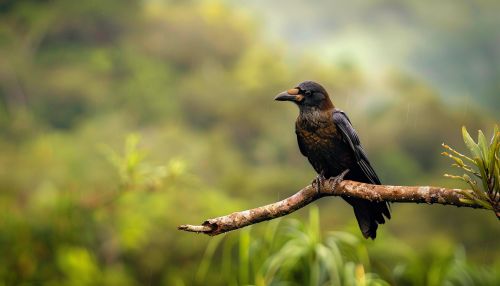New Caledonian crow
New Caledonian Crow
The New Caledonian crow (Corvus moneduloides) is a species of crow native to New Caledonia, an archipelago located in the southwest Pacific Ocean. This bird is particularly notable for its advanced cognitive abilities and sophisticated tool use, which have been the subject of extensive scientific research.


Taxonomy and Evolution
The New Caledonian crow belongs to the family Corvidae, which includes other crows, ravens, and magpies. The genus Corvus is known for its high intelligence and adaptability. The species Corvus moneduloides was first described by the French ornithologist Charles Lucien Bonaparte in 1853. Phylogenetic studies suggest that the New Caledonian crow diverged from other corvids approximately 3-5 million years ago, likely due to geographic isolation.
Physical Characteristics
New Caledonian crows are medium-sized birds, measuring about 40 centimeters in length. They have predominantly black plumage with a slight iridescent sheen. Their beaks are robust and slightly curved, adapted for manipulating objects and foraging. The eyes are dark brown, providing excellent vision, which is crucial for their complex behaviors.
Habitat and Distribution
This species is endemic to New Caledonia, where it inhabits a variety of environments, including humid forests, dry forests, and savannas. They are particularly abundant in areas with dense vegetation, which provides both food resources and materials for tool-making. The island's unique ecosystem has played a significant role in the evolution of the crow's specialized behaviors.
Diet and Foraging Behavior
New Caledonian crows have an omnivorous diet that includes insects, small vertebrates, fruits, and seeds. They are renowned for their ability to use tools to extract insects from tree bark and other hard-to-reach places. This behavior is not only rare among birds but also demonstrates a level of problem-solving ability comparable to that of some primates.
Tool Use and Manufacture
One of the most remarkable aspects of the New Caledonian crow is its sophisticated tool use. These crows have been observed using sticks, leaves, and even their own feathers to create tools. They manufacture tools by trimming and shaping natural materials, a behavior that requires foresight and planning.
Studies have shown that New Caledonian crows can create and use multiple types of tools, including hooked sticks and barbed leaves. These tools are used to extract insects and other prey from crevices. The crows' ability to understand the functional properties of different materials and to modify them for specific tasks is a subject of ongoing research.
Cognitive Abilities
The cognitive abilities of New Caledonian crows are a major area of interest for scientists studying animal intelligence. These birds have demonstrated problem-solving skills, causal reasoning, and even the ability to understand the concept of analogies. Experiments have shown that they can solve complex puzzles that require multiple steps and the use of different tools in sequence.
One famous experiment involved a crow named Betty, who bent a straight piece of wire into a hook to retrieve a bucket of food from a tube. This spontaneous innovation highlighted the crow's ability to understand the properties of the wire and to use it in a novel way to achieve a goal.
Social Structure and Communication
New Caledonian crows are social birds that often forage and roost in groups. They communicate using a variety of vocalizations and body language. Their social structure is believed to play a role in the transmission of tool-use knowledge, as young crows learn by observing and imitating older, more experienced individuals.
Reproduction and Lifespan
The breeding season for New Caledonian crows typically occurs from September to December. They build nests high in trees, using sticks and other plant materials. The female lays 2-3 eggs, which she incubates for about 20 days. Both parents participate in feeding and caring for the chicks, which fledge after approximately 40 days.
In the wild, New Caledonian crows can live up to 20 years, although their lifespan may be shorter due to predation and other environmental factors.
Conservation Status
The New Caledonian crow is currently listed as Least Concern by the International Union for Conservation of Nature (IUCN). However, habitat destruction and climate change pose potential threats to their population. Conservation efforts are focused on preserving their natural habitat and ensuring the sustainability of their food resources.
Research and Studies
Numerous studies have been conducted to understand the cognitive abilities and tool-use behaviors of New Caledonian crows. Researchers use a variety of methods, including field observations, controlled experiments, and neurobiological analyses. These studies contribute to our understanding of animal intelligence and the evolution of complex behaviors.
